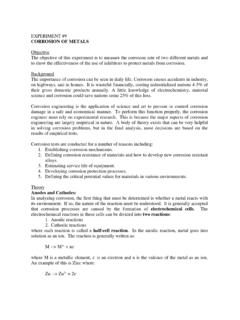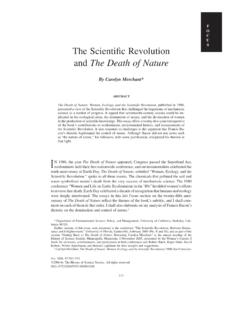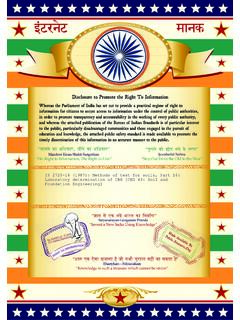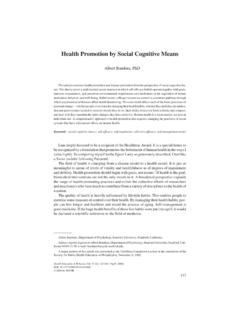Transcription of The Great Depression: California in the Thirties
1 The Great depression : California in the Thirties California was hit hard by the economic collapse of the 1930s. Businesses failed, workers lost their jobs, and families fell into poverty. While the political response to the depression often was confused and ineffective, social messiahs offered alluring panaceas promising relief and recovery. In spite of the general gloom of the decade, Californians continued to build and celebrate their Golden State. Hard Times Californians who lived through the 1920s and 1930s must have felt as though they were on a roller coaster. In a dizzying cycle of boom and bust, a decade of spectacular prosperity was followed by the worst economic collapse in the state's history. Ramshackle encampments, such as Pipe City in Oaklafilled with forlorn unemployed workers and their families. The crash of the Macohelium-filled dirigible, mirrored the collapsing fortunes of Californians times of the Thirties contributed to a disturbing resurgence of nativism; authond, n, a The rities shipped thousands of Mexican ic ers created in California an "Okie subculture," a way of life still flourishing today.
2 Francisco General Strike of 1934 paralyzed the bay area and attracted national attention. Boom and Bustdeportees across the border. Meanwhile, thousands of new Dust Bowl refugees from the heartland of America streamed into California seeking a better life. Their coming inspired John Steinbeck to write The Grapes of Wrath (1939) and Dorothea Lange to compile an epic photographrecord. The newcomDiscontented workers in the Thirties went on the offensive. Farmworkers and farm owners locked horns in yet another round of total engagement. The San onomic growth in California . Older industries expanded and new ones were founded. The decade of the 1920s was a time of booming ecBut the prosperity of the twenties was not well distributed. Proportionately, too much wealth was in profits and too little in wages. The income of many workers was so lowthat they couldn't afford to buy the products they produced. In other words, businesses produced more goods than could be consumed.
3 This la rge supply of unsold products weakened the economy. The crash of the stock market in 1929 was followed by the worst rms and their homes. Unemployment in the Golden State reached a staggering 28 percent in ears later one-fifth of all Californians were dependent upon public relief. depression in the history of California and the nation. Businesses and banks throughout the state closed their doors in the 1930s; thousands of individual investors and depositors lost everything. California farm income in 1932 sank to just half of what it had been in 1929. The number of building permits in 1933 was lessthan one ninth what it had been eight years earlier. Many property-owners lost their fa1932; two yPipe City Thousands of unemployed workers and their families lived in makeshift encampmentsthroughout California in the 1930s. One such village was near downtown Oakland where out-of-work residents lived in huge concrete sewer pipes being stored above ground.
4 Each six-foot section of concrete pipe became a "homeless shelter" for one of the neartwo hundred unemployed who lived there. Residents covered the ends of their pipes with burlap or cardboard, and survive ly d on mulligan stew made from discarded vegetables scavenged from nearby grocery wholesalers. They called their village "Miseryville," but s in Pipe City were typical of what the homeless faced everywhere during the depression . The Oakland Post-Inquirer on December 3, 1932, offered the following rness, and the concrete may seem less hard and the blankets less thin and the mulligan less watery. But it takes a lot of philosophy, you bet, to make concrete either he Crash of the Maconthe press dubbed it "Pipe City." Conditionaccount: "To qualify for citizenship in Pipe City you must be jobless, homeless, hungry, and preferably shoeless, coatless, and hatless. If one also is discouraged, lonely, filled with a terrible feeling of hopelessness and helplessness, one's qualifications are that much stronger.
5 One belongs. Not all of Pipe City's inhabitants are that way. Some of them have learned that a philosophical attitude helps. One may tinge his philosophy with a drop of irony, even bittesoft or warm!" T igible, three times longer than a The world's largest aircraft ever was the USS Macon, a helium-filled, aluminum-framed dirBoeing 747. This "lighter-than-air" craft, built for the Navy in 1933, tipped the scales at just over 120 tons. The Macon was returning home to Moffett Field on the San Francisco peninsula on tevening of February 12, 1935, when it was caught in a terrific rain squall off Point Sur. freakish gust of wind collapsed its upper tail fin, ripping holes in three of its helium ceThe huge airship quickly lost altitude and hit the water tail first. The mist-shrouded wreckage floated just long enough for all but two of its crew ohe A lls. f eighty-three to escape. With its nose pointing skyward and a mournful sigh of helium gasping from its open rosperous Californians.
6 Their collective epitaph was supplied by the radio operator of the Macon on that fateful evening in 1935. ry bulk dipped toward the sea at twilight, a single word flashed through the storm clouds off Point Sur: "Falling." wounds, the Macon slowly slipped beneath the waves. "She soared in her death throes," wrote one local journalist, "and was lost to view in the mist." The crash of the Macon was an event of symbolic importance. Its fate seemed to mirror the declining fortunes of millions of once pAs the Great silveDeportees Xenophobia and nativism experienced a resurgence during the Great depression . California nativists eagerly sought scapegoats to blame for the hard times of the 1930s. Filipinos were among the first to feel the brunt of anti-foreign hostility. White workers charged that recent immigrants from the Philippines posed an economic threat to native-born workers. Anti-Filipino riots broke out in several rural counties as well as in San Jose ded gram of mass repatriation.
7 Federal, state, and local authorities encouraged a voluntary exodus, but occurred. As many as 100,000 deportees left California for s expressed the pain of removal in poignant folk ballads: "Goodbye, my friends, Of the bad payment they give us." Dust Bowl Refugeesand San Francisco. In 1935 Congress passed the Filipino Repatriation Act, offering to pay the transportation expenses of any Filipinos who wished to return to their homeland. California nativists also complained that Mexican immigrants were taking much-neejobs away from American citizens. The federal government responded with a proforced deportations alsoMexico. The repatriadoYou are all witnesses Bowl refugees of the 1930s. A devastating Of all the stories of western Americans, none is quite so poignant as that of the Dust drought ravaged the farmlands of Oklahoma, Texas, and Arkansas; monstrous dust storms blackened the sky. George Turner, a resident of Oklahoma, later described what it was like when he and his family were hit by a blizzard of dust: "It was an unbelievable fornia .
8 Soon found, however, that conditions oody Guthrie wrote several ballads about the plight of the Dust Bowl refugees. In "Do Re Mi" he offered an unheeded warning about the unfulfilled n, a paradise to live in or see But believe it or not, you won't find it so hot do re mi." We seemed to be smothering in dust." Hundreds of thousands of residents of the Dust Bowl salvaged what they could, piled their belongings into rattling jalopies, and headed for the promised land of CaliThey hoped to find good jobs and a better life. Theyin California were not quite what they imagined. Jobs were scarce. And many Californians greeted the newcomers with hostility. Oklahoma-born song writer Wpromises of the Golden State: " California is a garden of EdeIf you ain't got theJohn Steinbeck The most enduring account of the Dust Bowl refugees' trek to California is John rk City where he worked as a construction laborer and reporter. In the 1930s he published a series of critically acclaimed novels, each set in California 's central ust still landowners launched a campaign to extend the ban to other counties.
9 The credibility of the opposition diminished following Steinbeck's receipt of the 40. Steinbeck's The Grapes of Wrath (1939). Steinbeck was born on February 27, 1902, in the farming town of Salinas. After attending Stanford University for six years (and failing to complete the requirements for a degree), he went to New Yocoast and valleys. Steinbeck began gathering material for The Grapes of Wrath by traveling among the DBowl refugees, viewing first hand the deplorable conditions of their lives and labor. When the novel was published in April 1939, it became a runaway best seller. DarrylZanuck of Twentieth-Century Fox released his film version of the book while it was at the top of the best seller lists. Not everyone was pleased with the book. The Kern County Board of Supervisors banned The Grapes of Wrath from public schools and libraries, and corporate Pulitzer Prize in 19 Dorothea Lange Photographer Dorothea Lange captured the plight of the Dust Bowl refugees in a series of ofessional photographer.
10 In 1918 she came to California and opened a studio in San Francisco. remarkable portraits, first published as An American Exodus (1940). Born in New Jersey in 1895, Lange knew by age 17 that she wanted to be a prLater, in the 1930s, an agency of the federal government hired her to make a photographic record of depressed conditions in the American South and Southwest. From this record came An American Exodus. ay San Luis Obispo. It is called Migrant Mother. Lange later described her experience: ound her, and seemed to know that my pictures might help her, and so she helped " An "Okie Subculture"Lange took the above photograph in 1936 at a pea pickers' camp in Nipomo, on Highw101, south of"I saw and approached the hungry and desperate mother, as if drawn by a magnet. I donot remember how I explained my presence or camera to her, but I do remember she asked me no She told me her age, that she was 32. She said that they had been living on frozen vegetables from the surrounding fields, and birds that the children had killed.

















